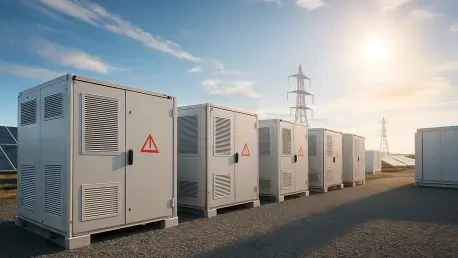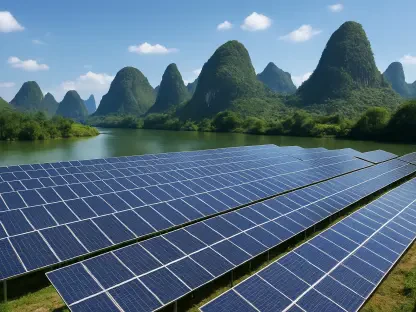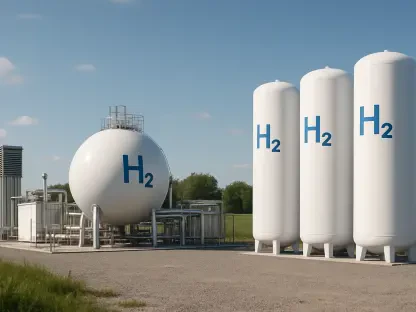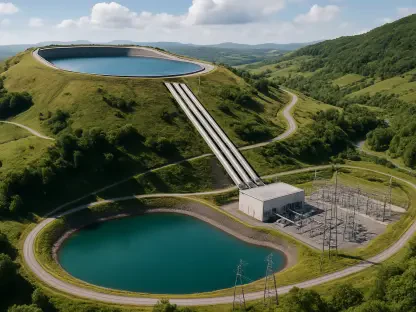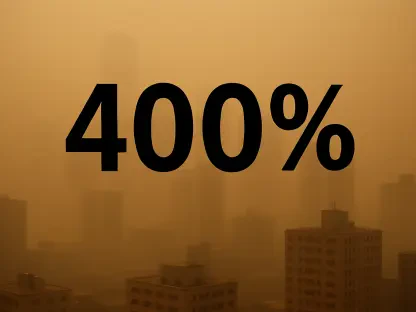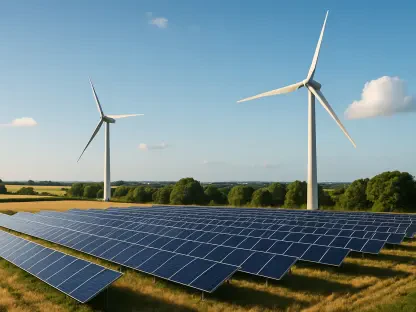The U.S. energy storage sector is witnessing an unprecedented wave of growth, positioning itself as a cornerstone of the nation’s transition to a cleaner, more reliable energy grid. In the second quarter of 2024, utility-scale battery energy storage systems (BESS) achieved a remarkable milestone with 4.9 gigawatts (GW) of power capacity and 15 gigawatt-hours (GWh) of energy capacity deployed, marking a 63% surge compared to the same period last year. When factoring in residential and commercial segments, total deployments soared to an all-time quarterly high of 5.6 GW/17.8 GWh. This boom underscores the vital role energy storage plays in balancing renewable energy sources like solar and wind while supporting grid stability amid rising demand. Yet, despite this momentum, a shadow looms on the horizon, with projections indicating a potential decline in utility-scale deployments by 2026 due to policy challenges and supply chain uncertainties, raising critical questions about the sector’s long-term trajectory.
Regional Powerhouses Driving the Surge
The remarkable growth in energy storage deployments is far from uniform across the U.S., with a handful of states leading the charge. California, Texas, and Arizona accounted for a staggering 75% of utility-scale capacity installed in the second quarter of 2024, fueled by a combination of progressive policies, access to abundant solar resources, and escalating electricity needs driven by population and industrial expansion. These regions have become hotbeds for large-scale projects, benefiting from regulatory frameworks that encourage investment and development. Their dominance highlights a clear disparity in how local conditions can shape the pace of adoption, with many other states lagging behind due to less favorable environments or slower policy adaptation. This concentration of progress raises questions about how to replicate such success on a broader scale to ensure equitable access to energy storage benefits nationwide.
Emerging as a notable contender, Arizona is carving out a significant role alongside traditional leaders like California and Texas. Its rise is attributed to a proactive regulatory stance that has fast-tracked major initiatives, such as the 100 MW/400 MWh White Tank battery storage project, expected to be operational by early 2027. Beyond policy support, Arizona’s appeal is amplified by rapid industrial growth, including new facilities from major corporations that are driving substantial electricity demand. This influx of economic activity necessitates robust energy storage solutions to maintain grid reliability, positioning the state as a model for how strategic planning and favorable conditions can accelerate sector growth. As other regions observe Arizona’s ascent, there is potential for similar strategies to inspire broader national development, though challenges in scaling these efforts remain evident.
Policy Barriers Casting a Shadow
Despite the current wave of success, the utility-scale energy storage sector faces significant headwinds that threaten to disrupt its upward trajectory. A projected 12% decline in deployments is anticipated by 2026, with a return to 2024 levels not expected until 2029, primarily due to restrictive federal policies on sourcing battery components from foreign entities. These regulations, coupled with fluctuating trade tariffs, have introduced uncertainty into the supply chain, making it difficult for developers to plan and execute projects with confidence. As electricity demand experiences its first increase in decades, driven by industrial and technological advancements, the urgency to address these policy barriers becomes paramount. Failure to navigate these challenges could jeopardize the sector’s ability to meet the nation’s growing energy needs.
Adding to the complexity, global trade tensions and shifting tariff policies have compounded the difficulties for manufacturers and project planners. The unpredictability of international sourcing rules creates a ripple effect, impacting timelines and costs for utility-scale initiatives. Developers are forced to reassess supply chains and seek alternative suppliers, often at higher expenses or with longer lead times, which can delay critical projects. This environment of uncertainty not only hampers immediate growth but also risks deterring long-term investment in the sector. Policymakers must prioritize clear, consistent guidelines to stabilize the market and ensure that energy storage can continue to support the integration of renewables and bolster grid resilience amid rising consumption trends.
Forecast Uncertainties and Permitting Hurdles
Predicting the future of energy storage remains a challenging endeavor due to a web of unresolved policy issues and logistical obstacles. Current forecasts present two scenarios—a base case and a low case—with a disparity of 16.5 GW in projected deployments over the coming years, reflecting lingering doubts about foreign sourcing regulations and supply chain bottlenecks. Additionally, tightening local permitting processes for solar and storage projects have introduced further delays, as communities and authorities grapple with balancing development needs against environmental and land-use concerns. While the gap between forecast scenarios has narrowed compared to earlier projections, the path forward is still fraught with risks that could impact the sector’s ability to sustain its current pace of expansion.
Beyond policy uncertainties, the practical challenges of navigating local regulations pose a significant barrier to project implementation. Developers often face lengthy approval processes and opposition from stakeholders, which can stall even well-funded initiatives. These permitting hurdles are particularly pronounced in regions without established frameworks for energy storage, where authorities may lack the expertise or resources to evaluate proposals efficiently. Addressing these issues requires collaboration between federal, state, and local entities to streamline processes and establish clear standards. Without such efforts, the sector risks missing critical windows of opportunity to build infrastructure that supports the nation’s energy transition goals, potentially undermining long-term grid stability.
Residential Storage as a Beacon of Hope
Amid the challenges facing utility-scale storage, the residential and distributed energy storage markets offer a promising counterbalance. Bolstered by supportive legislation such as the One Big Beautiful Bill Act (OBBBA), residential storage capacity is expected to nearly double by 2029, accompanied by a 41% rise in installations. This growth is driven by innovative financing models, including prepaid lease options and non-ownership structures, which make storage systems more accessible to homeowners. These developments indicate a shift toward diversification in the energy storage landscape, reducing reliance on large-scale projects and empowering individual consumers to contribute to grid stability through smaller-scale solutions.
Another key factor in the rise of distributed storage is the increasing adoption of virtual power plants (VPPs), managed by utilities or third-party aggregators. VPPs aggregate residential and commercial batteries to provide a cost-effective alternative to traditional utility-scale generators, enhancing grid flexibility and resilience. This approach allows for faster deployment and lower infrastructure costs, addressing some of the scalability issues faced by larger projects. As technology advances and more households integrate storage solutions, VPPs could play a transformative role in modernizing the energy grid. The momentum in this segment suggests that distributed resources will be a critical pillar of the sector’s future, complementing utility-scale efforts despite their projected downturn.
Path Forward Amidst Mixed Signals
Reflecting on the trajectory of the U.S. energy storage sector, it’s evident that the historic growth witnessed in 2024 set a powerful precedent for the role of storage in the nation’s energy landscape. The regional dominance of states like California, Texas, and Arizona showcased how targeted policies could drive progress, while the projected decline in utility-scale deployments by 2026 underscored the fragility introduced by federal restrictions and trade uncertainties. Meanwhile, the resilience of residential and distributed storage markets offered a glimmer of optimism in an otherwise complex scenario. Looking ahead, stakeholders must focus on actionable strategies, such as advocating for stable policy frameworks and investing in domestic supply chains, to mitigate risks. Encouraging collaboration between policymakers and industry leaders to streamline permitting and support innovative financing will also be crucial in sustaining momentum and ensuring that energy storage continues to meet the evolving demands of a modern grid.
